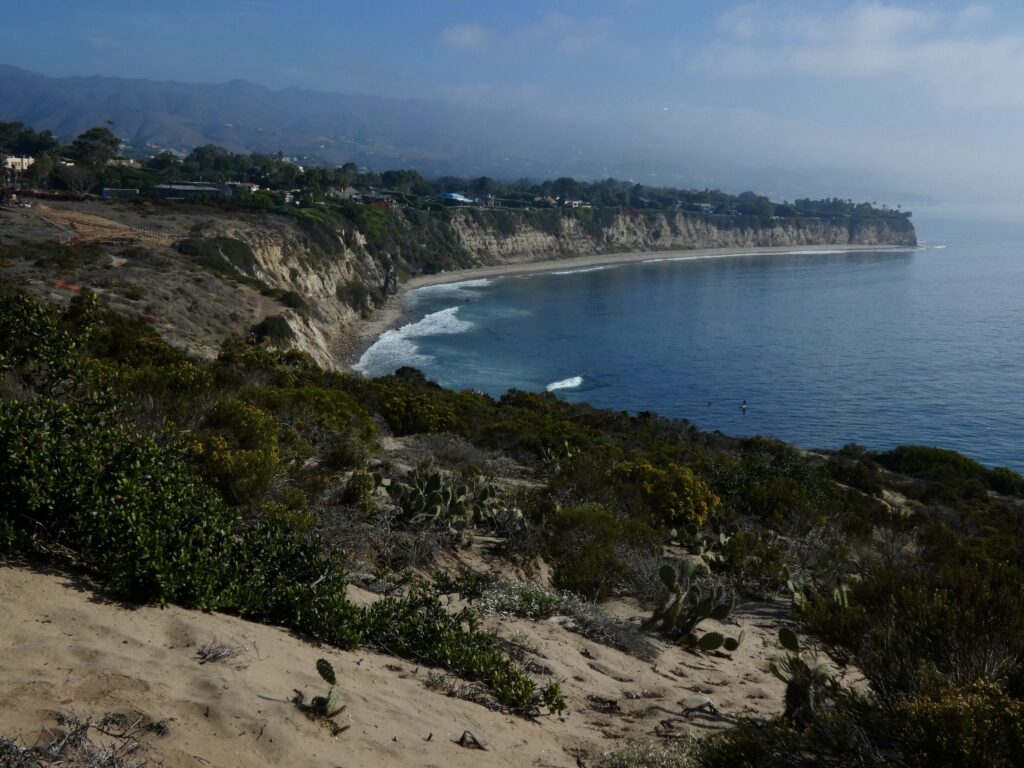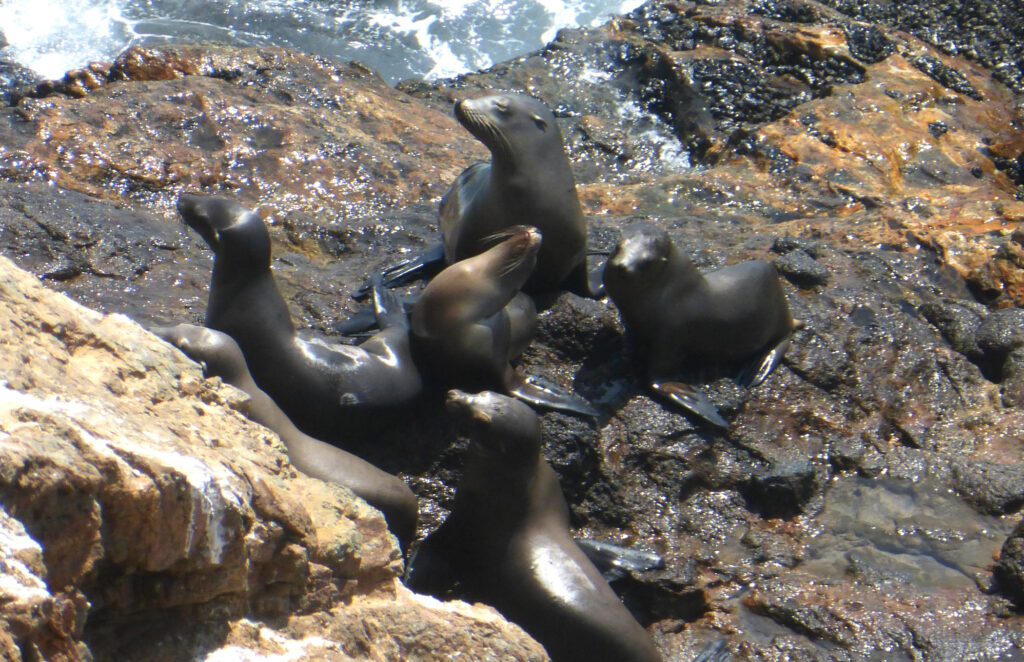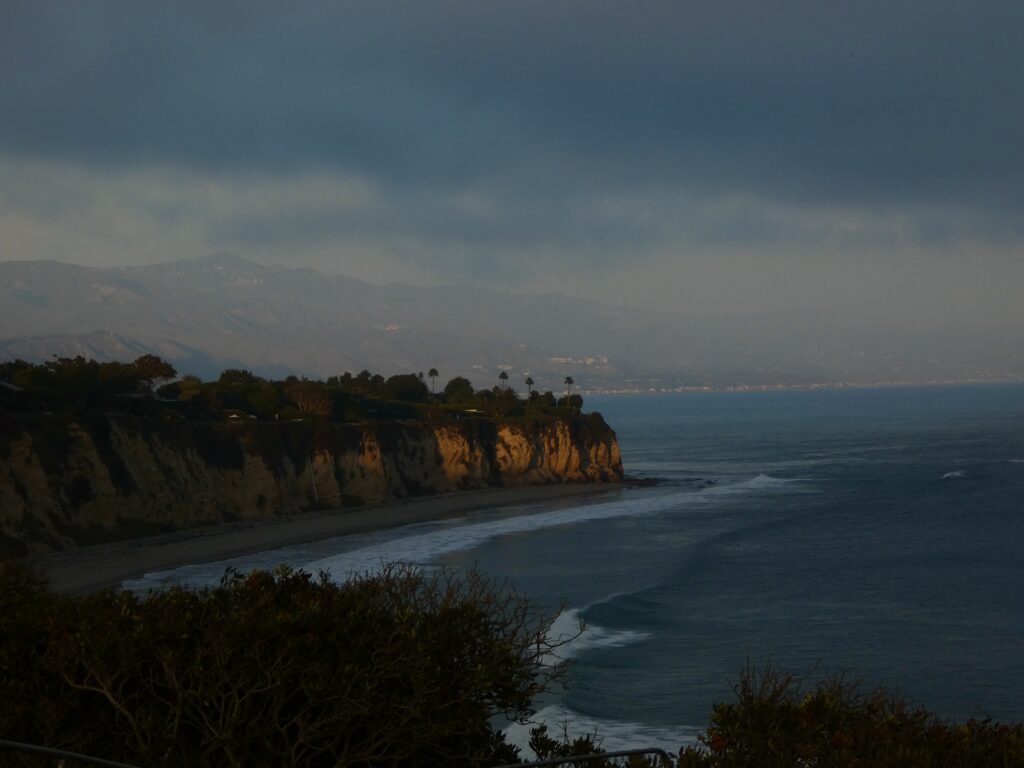
There’s a special place just a few miles up the coast, where whales, dolphins, and sea lions swim close to shore, where you can watch the sun or the moon rise and set, where there are golden flowers in the spring and vivid sunsets in the winter, and where there is peace and tranquility all year round.
Point Dume marks the western edge of the Santa Monica Bay. It’s also the western terminus of the Malibu Coast Fault, which leaves the land and continues under the sea floor to the Channel Islands. This point of land was born in fire and still has a heart of volcanic stone that makes it more resistant to erosion than the surrounding sedimentary rock.
The name Point Dume refers to several things: the geographic area from Paradise Cove in the east, to Zuma Creek in the west; the local surf break; the neighborhood built on the marine terraces of the Point Dume peninsula; and the southernmost tip of the peninsula, with its distinctive flat-topped peak, which is now Point Dume Natural Preserve and Point Dume State Beach.
There’s a plaque at the top of the promontory that proclaims it California Historical Landmark No. 965 and states that, “on November 24, 1793, English explorer George Vancouver, commander of an expedition to determine the extent of settlement of the northwest coast of America, named this rocky promontory Point Dume after his Franciscan friend, Father Francisco Dumetz, at Mission San Buenaventura.”
In actual fact, Vancouver named it “Point Duma”, not Dume, and a careful study of the historical record suggests an alternate interpretation: that Vancouver actually named the point for the Chumash community that still gives its name to Zuma Beach. It seems likely that both names were derived from the Chumash name Sumo, meaning “abundance.”
Either way, Point Dume was a noteworthy landmark for Vancouver, and long before that, it was an important site for the Chumash, who were also navigators and mariners, traveling long distances in their canoes called tomols.
The Chumash people used this south-facing point of land as a lookout and sacred site. A California State Parks study records that: “the site’s significance is related to its position and the grandeur of its views,” and adds that “the function of the site may best be summed up by Native American informant Fernando Librado, who stated that Point Dume ‘was used as a sun shrine.’”

Frederick Hastings Rindge, who purchased the entire Topanga Malibu Sequit Rancho in 1892, always had plans to build what he envisioned as an American Riviera, but he also loved the Point Dume area. The cattle station he maintained in Zuma Canyon was one of his favorite destinations on the vast, 13,000-acre ranch, and he makes the case in his 1903 book Happy Days in California that this area would be an ideal park.
His widow, Rhoda May Knight Rindge, did not share his vision. She authorized oil exploration on the point and along Zuma Beach. Fortunately for later generations and the environment, no oil was found.
May spent a significant part of the family fortune fighting to keep the railroad and then the coast highway out of Malibu, and suffered more big losses during the Depression. She filed for bankruptcy in 1938.
The following year, plans were released for a luxury resort development on the point, complete with polo fields, golf course, a huge hotel, a fake lighthouse and a massive breakwater right in the middle of the now-famous Point Dume surf break. The headlands would have been subdivided, leaving a tiny pie-wedge for the lighthouse. This scheme was derailed by WWII, but its name lives on in maps, including many map apps: “Mahou Riviera”.
The U.S. military commandeered the point as a lookout during WWII. They often get blamed for flattening the top of the point, but that was the work of post-war developers. The exact year that the top of Point Dume was bulldozed flat remains a point of contention, but survey markers on the flat top may hold the answer. They are dated 1947.
After the war, houses started going up, but it was a slow process. The first paved roads were built—and named—in 1946. The first houses were built the following year, but the community that eventually grew on the peninsula wasn’t the American Riviera once envisioned by the Rindge family. Instead, modest family homes were built, and the process was gradual.
Plans to build a hotel and resort on the Point didn’t surface again until the late 1960s, when they met fierce opposition.

Local activists successfully opposed the construction of a Marina Del Rey-type yacht harbor at Paradise Cove, and pushed tirelessly for the state to acquire the point, but the conservation fight was overshadowed by what was easily the weirdest environmental battle in local history: a multiyear fight between conservationists, State Parks, Los Angeles County, and nudists, over a hard-to-access beach called Pirates Cove. Before it was resolved, this fight was taken all the way to the Supreme Court.
Pirates Cove is a small pocket beach at the southern tip of what is now the Point Dume Natural Preserve. It has a history as a smugglers’ cove, although the pirates who used it were rum-runners and opium smugglers, not the walk-the-plank-me-hearty variety of an earlier era. It was also a historic sea lion rookery, although the population was decimated in the mid-twentieth century by over-hunting and poisoning from both the pesticide DDT and mercury from leaded petroleum products.
In the early 1970s, the state acquired Westward Beach and built a parking lot that made Pirates Cove less remote. However, this secluded stretch of coast was still only accessible at low tide, or over private property, and it had none of the amenities that Westward and Zuma beaches had, no lifeguards, restrooms, or trash cans.
Pirates Cove is familiar to film buffs as the location of the dramatic denouement of the original 1968 film Planet of the Apes, but it remained the domain of solitude seekers and the few remaining sea lions, until it became a destination for nudists.
Nudism was a big deal in the ’70s, part of the counterculture revolution. Naturists gathered at private clubs like the Elysian Fields in Topanga, and preached the gospel of personal freedom.
This was before the era of social media, but word spread that Pirates Cove was a clothing optional beach and crowds descended on the pocket beach. Nudists, and voyeurs ogling the nudists, gathered in the hundreds in the small cove. On at least one occasion, this small crescent of sand drew more than a thousand protesters.
A county ordinance banning nude bathing was passed in 1974, but it only added fuel to the controversy. Malibu residents became inured to life in a Monty Python sketch. Nude beachgoers wandered around the residential neighborhoods seeking alternate routes to the beach. Nude rock climbers were routinely rescued from the cliffs while attempting to clamber down to the beach from above.
The controversy around the nudists and the crowds they generated eventually threatened to derail the complex and delicate negotiations underway to buy the headlands, including Pirates Cove, for the state.
The property belonged at the time to developer Roy Crummer, Jr., a major Malibu landowner, and all of those nudists were trespassing. Although the recently passed Coastal Act made it legal for them to be on the beach below the mean high tide, there was no way to get there except over private property. The argument was made that a hotel would be less damaging to the environment than a public beach, because once the hotel was built the public could be kept out.
That argument gained traction after a 1978 protest attracted more than a thousand people to the cove. One volunteer who recalls the clean-up effort after that 1,000-nudist flash mob went home for the day described it as “indescribable.”
Ultimately, the state purchased the headlands in 1979, undeterred by the controversy. Pirates Cove was closed by the county in 1980, ostensibly to help it recover from the ecological damage, but the closure was overturned and the nudists returned.
The state’s response was to propose a parking lot atop the headlands to make it easier for the nudists to park. The nudists continued to push for official recognition, lobbying for Point Dume and seven other beaches to be designated clothing optional.
In 1994, the U.S. Supreme Court had the final word: nudity is not a Constitutional right. “Better not bare your bottom at the beach,” the Los Angeles Times quipped following the ruling.

The losers of the Malibu fight over public nudity were the sea lions. The rookery was never reestablished, despite the hopes of conservationists. The species is a conservation success story statewide, and sea lions still haul out on the rocks nearby, but the local colony gives birth in the safety of the Channel Islands, not at Pirates Cove.
Thanks to local opposition, the parking lot plan was abandoned. The park, now the only undeveloped section of coastal bluff in the area, was given new protections as a nature preserve in 1992, the same year that Malibu finally became a city. It’s a small park, but it is home to an astonishing variety of plants and wildlife, including the endemic giant coreopsis, that turns the headlands golden in the spring, to a rare and rarely seen species of legless lizard.
Point Dume houses have grown bigger and exponentially more expensive, and there aren’t many empty lots or fields left, but Point Dume’s landmark promontory is permanently protected as a state nature preserve. The view from the top of the Point looking out across the open ocean, or up the coast to Sequit Point in the distance looks much as it must have to the ancient Chumash. People still come here to watch for whales in winter, or to see the sunrise and the sunset, and there are protections in place now for the waters off the point. In 2011, the beach and ocean below the point were designated a Marine Protected Area, with the highest level of environmental protection. It’s an acknowledgement of the amazing biodiversity of this exceptional place.






